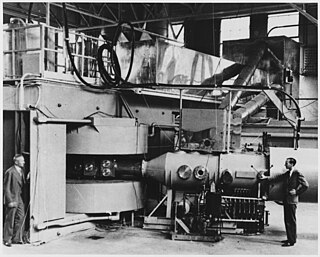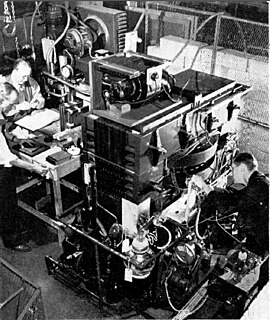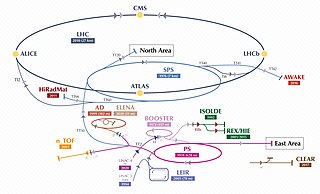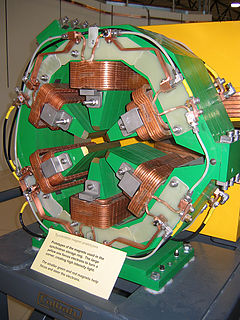
A cyclotron is a type of particle accelerator invented by Ernest O. Lawrence in 1929–1930 at the University of California, Berkeley, and patented in 1932. A cyclotron accelerates charged particles outwards from the center of a flat cylindrical vacuum chamber along a spiral path. The particles are held to a spiral trajectory by a static magnetic field and accelerated by a rapidly varying electric field. Lawrence was awarded the 1939 Nobel Prize in Physics for this invention.

The Tevatron was a circular particle accelerator in the United States, at the Fermi National Accelerator Laboratory, east of Batavia, Illinois, and is the second highest energy particle collider ever built, after the Large Hadron Collider (LHC) of the European Organization for Nuclear Research (CERN) near Geneva, Switzerland. The Tevatron was a synchrotron that accelerated protons and antiprotons in a 6.28 km (3.90 mi) ring to energies of up to 1 TeV, hence its name. The Tevatron was completed in 1983 at a cost of $120 million and significant upgrade investments were made during its active years of 1983–2011.
Accelerator physics is a branch of applied physics, concerned with designing, building and operating particle accelerators. As such, it can be described as the study of motion, manipulation and observation of relativistic charged particle beams and their interaction with accelerator structures by electromagnetic fields.

In accelerator physics, a beamline refers to the trajectory of the beam of accelerated particles, including the overall construction of the path segment along a specific path of an accelerator facility. This part is either

A dipole magnet is the simplest type of magnet. It has two poles, one north and one south. Its magnetic field lines form simple closed loops which emerge from the north pole, re-enter at the south pole, then pass through the body of the magnet. The simplest example of a dipole magnet is a bar magnet.

The Large Electron–Positron Collider (LEP) was one of the largest particle accelerators ever constructed. It was built at CERN, a multi-national centre for research in nuclear and particle physics near Geneva, Switzerland.

A synchrotron is a particular type of cyclic particle accelerator, descended from the cyclotron, in which the accelerating particle beam travels around a fixed closed-loop path. The magnetic field which bends the particle beam into its closed path increases with time during the accelerating process, being synchronized to the increasing kinetic energy of the particles. The synchrotron is one of the first accelerator concepts to enable the construction of large-scale facilities, since bending, beam focusing and acceleration can be separated into different components. The most powerful modern particle accelerators use versions of the synchrotron design. The largest synchrotron-type accelerator, also the largest particle accelerator in the world, is the 27-kilometre-circumference (17 mi) Large Hadron Collider (LHC) near Geneva, Switzerland, built in 2008 by the European Organization for Nuclear Research (CERN). It can accelerate beams of protons to an energy of 6.5 teraelectronvolts (TeV).

A betatron is a type of cyclic particle accelerator. It is essentially a transformer with a torus-shaped vacuum tube as its secondary coil. An alternating current in the primary coils accelerates electrons in the vacuum around a circular path. The betatron was the first machine capable of producing electron beams at energies higher than could be achieved with a simple electron gun.
A particle beam is a stream of charged or neutral particles. In particle accelerators, these particles can move with a velocity close to the speed of light. There is a difference between the creation and control of charged particle beams and neutral particle beams, as only the first type can be manipulated to a sufficient extent by devices based on electromagnetism. The manipulation and diagnostics of charged particle beams at high kinetic energies using particle accelerators are main topics of accelerator physics.

The Proton Synchrotron is a particle accelerator at CERN. It is CERN's first synchrotron, beginning its operation in 1959. For a brief period the PS was the world's highest energy particle accelerator. It has since served as a pre-accelerator for the Intersecting Storage Rings (ISR) and the Super Proton Synchrotron (SPS), and is currently part of the Large Hadron Collider (LHC) accelerator complex. In addition to protons, PS has accelerated alpha particles, oxygen and sulfur nuclei, electrons, positrons, and antiprotons.
Radiation damping in accelerator physics is a way of reducing the beam emittance of a high-velocity charged particle beam by synchrotron radiation.
Migma, sometimes migmatron or migmacell, was a proposed colliding beam fusion reactor designed by Bogdan Maglich in 1969. Migma uses self-intersecting beams of ions from small particle accelerators to force the ions to fuse. Similar systems using larger collections of particles, up to microscopic dust sized, were referred to as "macrons". Migma was an area of some research in the 1970s and early 1980s, but lack of funding precluded further development.

In accelerator physics strong focusing or alternating-gradient focusing is the principle that the net effect on a particle beam of charged particles passing through alternating field gradients is to make the beam converge. By contrast, weak focusing is the principle that nearby circles, described by charged particles moving in a uniform magnetic field, only intersect once per revolution.

A particle accelerator is a machine that uses electromagnetic fields to propel charged particles to very high speeds and energies, and to contain them in well-defined beams.

A sextupole magnet consist of six magnetic poles set out in an arrangement of alternating north and south poles arranged around an axis. They are used in particle accelerators for the control of chromatic aberrations and for damping the head tail instability. Two sets of sextupole magnets are used in transmission electron miscoscopes to correct for spherical aberration.

A storage ring is a type of circular particle accelerator in which a continuous or pulsed particle beam may be kept circulating typically for many hours. Storage of a particular particle depends upon the mass, momentum and usually the charge of the particle to be stored. Storage rings most commonly store electrons, positrons, or protons.
A Fixed-Field alternating gradient Accelerator (FFA) is a circular particle accelerator concept on which development was started in the early 50s, and that can be characterized by its time-independent magnetic fields and the use of strong focusing. Thus, FFA accelerators combine the cyclotron's advantage of continuous, unpulsed operation, with the synchrotron's relatively inexpensive small magnet ring, of narrow bore.
The High Energy Accelerator Research Organization KEK digital accelerator (KEK-DA) is a renovation of the KEK 500 MeV booster proton synchrotron, which was shut down in 2006. The existing 40 MeV drift tube LINAC and RF cavities have been replaced by an electron cyclotron resonance (ECR) ion source embedded in a 200 kV high-voltage terminal and induction acceleration cells, respectively.
In accelerator physics, a magnetic lattice is a composition of electromagnets at given longitudinal positions around the vacuum tube of a particle accelerator, and thus along the path of the enclosed charged particle beam. The lattice properties have a large influence on the properties of the particle beam, which is shaped by magnetic fields. Lattices can be closed, linear and are also used at interconnects between different accelerator structures.

The Future Circular Collider (FCC) is a proposed post-LHC particle accelerator with an energy significantly above that of previous circular colliders. The FCC project examines scenarios for three different types of particle collisions: hadron collisions in a collider design known as FCC-hh, electron–positron collisions in a collider design known as FCC-ee, and proton–electron collisions in a collider design known as FCC-eh.











